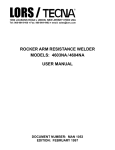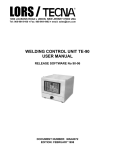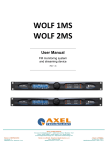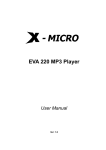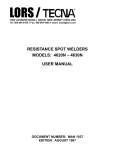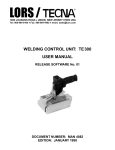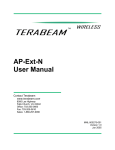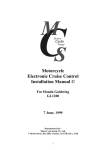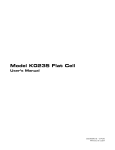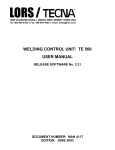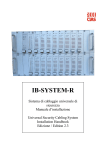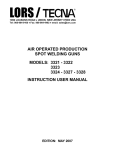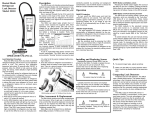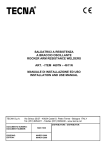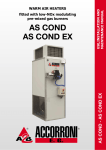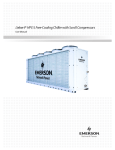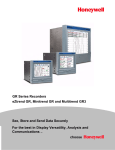Download Rocker Arm Resistance Welder 4608NA-4609NA
Transcript
LORS / j 1090 LOUSONS ROAD ♦ UNION, NEW JERSEY 07083 USA Tel: 908-964-9100 ♦ Fax: 908-964-4492 ♦ email: [email protected] ROCKER ARM RESISTANCE WELDER MODELS: 4608NA / 4609NA USER MANUAL DOCUMENT NUMBER: MAN 1052 EDITION: FEBRUARY 1997 LORS / TECNA DOCUMENT NUMBER: MAN1052 ROCKER ARM WELDER: 4608NA / 4609NA EDITION: FEBRUARY 1997 Page 2 / 32 LORS / TECNA ROCKER ARM WELDER: 4608NA / 4609NA ― INDEX ― CONTENTS 1 2 3 4 PAGE INTRODUCTION 4 1.1 PRELIMINARY REMARKS 4 1.2 SYMBOLS ON BOTH WELDER AND MANUAL 4 1.3 STANDARD ACCESSORIES 4 TECHNICAL FEATURES 5 2.1 IDENTIFICATION DATA 5 2.2 ELECTRICAL DATA 5 2.3 MECHANICAL DATA 5 2.4 COMPRESSED AIR CONNECTION DATA 6 2.5 COOLING CIRCUIT CONNECTION DATA 6 2.6 ADDITIONAL FEATURES 6 2.7 WELDER MAIN FEATURES 7 2.8 WELDING CONTROL UNIT TE 90 DESCRIPTION 7 INSTALLATION 8 3.1 PLACE OF INSTALLATION 8 3.2 UNPACKING AND TRANSPORT 8 3.3 PNEUMATIC INSTALLATION 8 3.4 COOLING WATER INSTALLATION 8 3.5 ELECTRICAL INSTALLATION 9 WORKING PROCESS 10 4.1 MECHANICAL SET-UP 11 4.2 ELECTRODE FORCE ADJUSTMENT 13 4.3 WORKING PROGRAM ADJUSTMENT 13 4.4 CALCULATION OF THE MAXIMUM WELDING RATING 14 5 SAFETY RULES 15 6 ACCESSORIES AND SPARE PARTS REQUEST 16 7 MAINTENANCE 17 7.1 8 9 ORDINARY MAINTENANCE 17 7.2 EMERGENCY CONDITION WARNINGS 18 7.3 EXTRAORDINARY MAINTENANCE 18 7.3.1 LOWERING OF THE WELDING UNIT PERFORMANCES 18 7.3.2 TROUBLESHOOTING 18 7.3.3 REMEDIES FOR WELDS IMPERFECTIONS 20 ENCLOSURES 21 8.1 WELDING TABLES 21 8.2 PRODUCTION FORM FACSIMILE 22 TECHNICAL DOCUMENTATION 23 MACHINE OVERALL DIMENSIONS 23 ELECTRICAL DRAWING 24 PNEUMATIC DRAWING 25 COOLING CIRCUIT DRAWING 25 EXPLODED DRAWING 26 10 CONTROL DOCUMENTATION (TE90) DOCUMENT NUMBER: MAN1052 29 EDITION: FEBRUARY 1997 Page 3 / 32 LORS / TECNA ROCKER ARM WELDER: 4608NA / 4609NA 1 INTRODUCTION 1.1 PRELIMINARY REMARKS CAREFULLY READ THIS MANUAL BEFORE INSTALLING AND OPERATING THE WELDER. This manual is addressed to the factory responsible in charge who must release it to the personnel in charge of both welder installation, use and maintenance. He/she must check that the information stated on this manual and on the enclosed documents have been read and understood. The manual must be stored in a well-known place, in an easily accessible area, and must be looked up each time even little doubts should arise. This welder has been designed for resistance welding of ferrous materials. The welder must not be used for other applications, i.e. pieces heating, mechanical working carried out by using the electrodes force. The welder has been designed for being used by an operator by means of the foreseen control devices. All modifications, even slight ones, are forbidden. TECNA S.p.A. is not responsible for any damage to both people, animals, things and to the welder itself caused by either a improper use or the lack or the superficial observance of the safety warnings stated on this manual, nor is it responsible for damages coming from even slight tampering or from the use of not-suitable spare parts, or of spare parts other than the original ones. 1.2 SYMBOLS ON BOTH WELDER AND MANUAL k WARNING! Important safety information enclosed in this paragraph. 1.3 STANDARD ACCESSORIES The welder is supplied equipped with the following accessories: N° 1 Allen wrench set 4-5-6-8 mm. N° 1 Socket wrench 30-32 mm. N° 1 High conductivity grease pot. N° 1 Fast clutch for hoses Ø10 mm (for pneumatic circuit connection). N° 1 TE90 control unit instruction manual. N° 1 Welder use and maintenance manual. Check that the welder is equipped with all the standard accessories; immediately inform the manufacturer in case some components are missing or damaged. DOCUMENT NUMBER: MAN1052 EDITION: FEBRUARY 1997 Page 4 / 32 LORS / TECNA ROCKER ARM WELDER: 4608NA / 4609NA 2 TECHNICAL FEATURES 2.1 IDENTIFICATION DATA Item 4608NA Year of manufacturing Serial number Mains voltage 220/440 V Mains frequency 60 Hz. Machine supplied with voltage set for V 2.2 ELECTRICAL DATA Item 4608NA 4608NA Mains voltage V 440 220 Mains frequency Hz 60 60 Nominal power at 50% duty cycle KVA 20 20 Maximum welding power KVA 50 50 Short circuit secondary current kA 15 15 Maximum welding current on steel kA 12 12 Secondary thermal current at 100% A 3350 3350 Secondary no load alternate voltage V 4.2 4.2 Delayed fuses A 32 63 mm² AWG 10 7 25 3 mm² AWG 10 7 35 2 KVA 58 58 Mains cables section for L=10 m * Mains cables section for L=30 m * Supply transformer minimum power ** * Section for every cable, calculated for PVC insulated, single conductor cables, considering the welder working at the maximum welding power, as well as a 4% voltage drop on cables. ** Approximate value, calculated for a three-phase transformer with a 4% short circuit voltage, with 6% voltage drop on transformer and a 4% voltage drop on cables, with the welder adjusted for the maximum welding power. 2.3 MECHANICAL DATA Item 4608NA Min. electrodes throat depth 230 mm - 9 inch Electrode force at 6 bar (600 kPa - 87 psi) 240 daN - 528 lbs Max. working stroke 44 mm - 1 3/4 inch Max. electrodes throat depth 550 mm - 21 1/2 inch Electrode force at 6 bar (600 kPa - 87 psi) 95 daN - 209 lbs Max. working stroke 85 mm - 3 1/4 inch Arms diameter 40 mm Electrode-holder diameter Electrodes cone Net weight of the machine DOCUMENT NUMBER: MAN1052 25.4 mm - 1 inch Standard Special 2MT / 5RW 122 kg - 270 lbs EDITION: FEBRUARY 1997 Page 5 / 32 LORS / TECNA ROCKER ARM WELDER: 4608NA / 4609NA 2.4 COMPRESSED AIR CONNECTIONS DATA Item 4608NA Minimum pressure bar kPa psi 6.5 650 94 Maximum pressure bar kPa psi 10 100 145 Hoses minimum inside diameter 8 mm - 3/8 inch Consumption for 1000 spots at 6 bar (600 kPa) with maximum working stroke with 20 mm working stroke and arms length adjusted to the minimum value Nm3 4.3 3 2.8 Nm 2.5 CIRCUIT CONNECTION DATA Minimum water pressure bar kPa psi 2.5 250 36 Maximum water pressure bar kPa psi 4 400 58 Hoses inside diameter - input/output 8 mm 3/8 inch Minimum consumption for nominal power 180 l/h - 48 gal/h 2.6 ADDITIONAL FEATURES Item 4608NA Standard: gray - RAL7032 Machine painting color ........................................... Aerial noise produced -Continuous equivalent acoustic pressure level; a weighed value dB (A) < 70 Measurement position h=1.60 m L=0.5 m Measurement conditions DOCUMENT NUMBER: MAN1052 working stroke (mm) 20 welding time (cycles) 17 welding current (kA) 11 working rating (welds/min) 10 EDITION: FEBRUARY 1997 Page 6 / 32 LORS / TECNA ROCKER ARM WELDER: 4608NA / 4609NA 2.7 WELDER MAIN FEATURES • Rocker arm pneumatic spotwelder with microprocessor welding control unit. • Adjustable arms, enabling to adjust the welder according to the work exigencies. • Chrome-copper electrode-holders for heavy duty and long life, designed for both straight and angled assembling. • Adjustable electrodes stroke, enabling to reach the max. working rate. • Water-cooled transformer, with epoxy resin coated windings. • Water cooled arms, electrode-holders and electrodes. • Synchronous SCR contactor insulated from cooling water circuit with protection thermostat. • Designed for both single and automatic cycle. • Two stage electric foot switch allowing clamping and correct set up of the part during the first stage before proceeding to weld in the second stage. • The welder has been designed for connecting a second two stage electric foot. This additional electric foot enables the recalling of the twin pre-setting for time and current, useful when it is necessary to carry out two different welds on the same piece. • 24 Vdc 5 way solenoid valve. • Double effect pneumatic cylinder, lubrication free against oil mist. • Electrodes force adjustable by means of a protect built-in compressed air filter unit with gauge-pressure; with semi-automatic moisture discharging. • Electrodes speed regulators (both opening and closing), cylinder end-stroke shock absorber, and silencers for compressed air discharge assuring the minimum noise. 2.8 WELDING CONTROL UNIT TE-90 DESCRIPTION TE-90 is a microprocessor welding control unit for single-phase resistance welders. The welding control unit is used to control the welder components and in particular, the thyristor adjusting the welding current. The TE-90 working cycle is described through 12 programming parameters. MAIN FEATURES • Synchronous thyristor drive, phase shift control for welding current adjustment. • Simplified programming by means of four push-buttons. • Twin pre-setting for time and current, recallable by two independent controls. • Slope and pulse functions. • Single and automatic (repeat) operating mode. • Secondary current compensation function for the welding of oxidized sheets and rods. • First phase shift delay adjustment. It enables the machine line current best balance. • Control of solenoid valve 24 Vdc 7.2 W Max with protected output against short circuits. • "Watch-dog" safety circuit stopping the welder in case of control unit faulty operation, micro-interruptions or too high voltage drop. For further information concerning TE-90 see page 29. DOCUMENT NUMBER: MAN1052 EDITION: FEBRUARY 1997 Page 7 / 32 LORS / TECNA ROCKER ARM WELDER: 4608NA / 4609NA 3 INSTALLATION These paragraphs are addressed to the specialized personnel in charge of both welder handling and installation. The welder dimensions drawing, placed in last pages of this manual, providing useful information for carrying out these operations. 3.1 PLACE OF INSTALLATION The welder must be installed in a position to allow the following features: • In a controlled, enclosed environment. The welder has not been designed for being used outdoors. • Room temperature included between 0 and 40 °C (If water is removed, storage is allowed down to 20°C below 0); 1000 m. maximum altitudes. • In a well ventilated area, free from dust, steam, and acid exhalations. • The working place must be free from inflammable materials because the working process can produce spatters of melted metal. • Around the welder there must be enough room to carry out both working and maintenance in a comfortable manner and without any risk. • In a place with a suitable lighting system in comparison with the work to be carried out. • The place of installation must necessarily be flat and the ground must be without unevenness which can be dangerous during the working. If the welder is used to carry out welding processes which can cause smoke exhalations, there must be installed a proper aspirator. The welder must be carefully fixed to the floor through the proper holes placed on the welder basement. Do not install nearby the welder neither supporting tables, nor equipment limiting the approaching to the devices and/or making inaccessible or ineffectual the safety devices. 3.2 UNPACKING AND TRANSPORT On receipt of the welder, verify the perfect integrity of the outer package; report to a responsible person in charge any possible anomalies which should be noticed. Possible damages on the outer package should arise some doubts on the integrity of its content. Remove the package and visually verify the welder integrity. Check that the welder is equipped with all the standard components; immediately inform the manufacturer in case some components are missing. All the material forming the package must be removed according to the present environmental protection regulations. The welder barycentre is high from ground. For this reason, the welder must be moved only by means of the proper attachment placed on the top of the welder. Consider the welder weight stated on the "TECHNICAL FEATURE" paragraph. 3.3 PNEUMATIC INSTALLATION For a correct compressed air supply to the welder, it is necessary either a centralized system or a compressor capable of supplying dry air cooled within the maximum pressure limits and in the quantity stated on the paragraph "Technical Features". Pay attention to the hoses minimum diameter stated on the same paragraph. In case the line is subject to great pressure variations, it is advisable to supply the welder by means of a tank of at least 50-100 liters, equipped with a gauge-pressure supplied by means of a one-way valve. The machine is equipped with a filter unit; periodically discharge the moisture. The welder has been assembled by using components which do not require lubrication. The insertion of a lubricator in the circuit causes no problems to the welder; nevertheless, pay attention to the fact that this causes the emission of oil mist in the environment. 3.4 COOLING WATER INSTALLATION For a correct cooling of the welder it is necessary clean water at a maximum temperature of 30°C at the quantity stated on the paragraph "Technical features". When connecting the unit to the water line check for dirt or packing scraps in the hoses and connect the supply to the inlet, and the drain to the outlet, this to allow that the still cool water immediately reaches the parts of the welder most subject to heating. Different cooling circuit systems are available: with city supply water, with re-circulating water, with heat exchanger (air-water) and with refrigerator. If the circuit is with city supply or refrigerator and you are working in presence of high humidity, we suggest to avoid the use of low temperature water, as this could produce moisture inside the machine. In presence of hard water it is necessary to install a water softener at the cooling circuit inlet hose, this to avoid that deposits obstruct or reduce the water channels in the welder, thus causing damages. If the machine is operated in a re-circulating water supply, the water softener must be placed on the supply of the cooling water tank; the insertion before the machine generates damages. DOCUMENT NUMBER: MAN1052 EDITION: FEBRUARY 1997 Page 8 / 32 LORS / TECNA ROCKER ARM WELDER: 4608NA / 4609NA 3.5 ELECTRICAL INSTALLATION Installation must be carried out by specialized personnel only, and must adhere to all local safety rules. As this unit can be supplied for different power supply versions, before connecting the unit to the power line, check if the voltage shown on the features plate corresponds to the one of your power supply. Consult the "technical features" paragraph to determine the cables section to be used, according to their length. On this paragraph you find also the values of the fuses which must be placed on the welder supply input. Fuses must be delayed type only. Connect machine to earth by using a cable having the same section of the mains cable. In order to facilitate the maintenance operation, we recommend you to supply the welder machine by means of a mains disconnecting switch. The welder has been designed for work with voltages of 220 or 440 supply. It is shipped with the voltage marked on the back and data plate of the machine. If you desire a different voltage you must follow the following instructions. TRANSFORMER AND CONTROL VOLTAGE CONNECTIONS WELD TRANSFORMER WIRING The transformer your 4608NA is equipped is capable of 220 or 440 volt operation. To change the transformer voltage you must insure that the wire are on the correct taps. For 220 volt operation be sure that the two wires are on the lower two terminals marked 220V and 0V as shown in figure one. 440 | TRANSFORMER 220 VOLT OPERATION Figure 1 220 | 0| For 440 volt operation connect the two wires to the outer most terminals marked 440V and 0V as shown in figure two. 440 | TRANSFORMER 440 VOLT OPERATION Figure 2 220 | 0| The common wire remains the same for both voltages. CONTROL TRANSFORMER CONNECTIONS 0 24 440 380 220 0 FIGURE 3 - Six terminal barrier (mounted on the top of the control transformer) To change voltage, loosen screw terminals and insert wire into the position that matches your line voltage. A C B To set the voltage on the control transformer follow the directions : 1. Locate the control transformer located on the back of the control panel. 2. For 440 volt operation there must be a wire install in position "A" (see FIGURE 3). If the wire is not installed in position "A" remove the wire from position "B" or "C" and reinstall it in position "A". 3. For 220 volt operation the wire must be installed in position "B" (see FIGURE 3) The wire must be installed in position "A" or position "B" not in both. The position of the labeled wire are not to be changed. The only wire you can change is on the opposite side of the labeled wires on the Terminal Barrier. DOCUMENT NUMBER: MAN1052 EDITION: FEBRUARY 1997 Page 9 / 32 LORS / TECNA ROCKER ARM WELDER: 4608NA / 4609NA 4 WORKING PROCESS The welder has been designed for being used by an operator placed in front of the unit and operating on the welder same working plane. When arranging the working place, always follow the herewith stated instructions: • Use a well ventilated area, free from dust, steam, and acid exhalations. • The working place must be free from inflammable materials because the working can produce spatters of melted metal. • Around the welder there must be enough room to carry out both working and maintenance in a comfortable manner and without any risk. • If the welder is used to carry out welding processes which can cause smoke exhalations, there must be installed a proper aspirator. • Do not install on the welder neither supporting tables nor equipment which either limit the approaching to the devices or make inaccessible or ineffectual the safety devices. Before starting the working process, carry out the following adjustments: 1234- Mechanical set-up Electrode force adjustment Welding parameters adjustment Calculation of the maximum welding rating The following paragraphs carefully explain these different phases. Before starting the working process: • • • • • Check that all the safety instructions have been operated. Check that the automatic cycle is inserted only when it is really used. Check that the pneumatic circuit is supplied. Check the correct functioning of the control devices; at the first stage, the foot control must have a 10-12 mm stroke. Additional foot-control (which is supplied on request): if it is not used when working, disconnect it and remove it from the working place. • Carry out some test cycles in order to verify both the cycle correctness and the operating speeds. These tests should be carried out without current circulation by means of the WELD/NO WELD selector placed on the control unit. Before starting the welding process, check the welding conditions (time, pressure, etc.). Use two off-cuts of the sheet to weld, carry out two spots at the same distance used during the production, then remove the first and check the second: the spot is correct when the pulling test causes the coming out of the weld nugget with the hole of a sheet, and the twist test shows a pure area without porosity or causes the coming out of the nugget. X= SAME DISTANCE OF SPOTS IN PRODUCTION REMOVE THE FIRST SPOT FIRST SPOT TWIST TEST PULLING TEST During the production it is advisable to monitor those parameters which can alter the working conditions, and thus the welds quality. Always monitor the electrodes which must always be clean, without any deformation and must have the proper diameter according to the work to be carried out. DOCUMENT NUMBER: MAN1052 EDITION: FEBRUARY 1997 Page 10 / 32 LORS / TECNA ROCKER ARM WELDER: 4608NA / 4609NA Check that there is not strong changing in the welder supply pressure as this could modify the force on the electrodes and thus the welding quality. Do not use sealing products to remove water losses on the electrodes conic connection. To facilitate the electrode removal and to prevent from both cone seizure and water losses, use high conductivity grease similar to the standard one. The cooling water must circulate inside the welder for a few minutes after having completed the production in order to allow the welder cooling. To prevent from both losses and moisture deposits, do not leave the cooling circuit open when the unit is not used. Electrodes must not be used to force the clamping of the pieces to weld. We recommend you to notice the adjustments carried out for each type of piece. In order to make it easier, a specific table has been added at the end of this manual. 4.1 MECHANICAL SET UP Arms and electrodes adjustment The arms length can be adjusted in comparison with the different working exigencies. The lengthening of the arms causes a decreasing of the performances, so that it is advisable always to work with the shortest available length. Under working conditions, both arms and electrodes holder must be adjusted in order to have the electrodes tip coincide. Carry out some tests with the control unit on NO WELD mode, using the same electrodes force employed to carry out the work; place among the electrodes a thickness equal to that which must be weld. If it is necessary, pull out both arms and electrodes holder and carry out the adjustment operations. It is advisable to adjust electrodes with a fine file or with sandpaper. The best performances can be reached by using sand paper folded upon a support having the same thickness of the sheets to weld. In case of steel welding, the electrodes diameter should correspond to the values shown on the following table. Sheet thickness mm 0.5 inches .021 0.8 1 .031 .040 1.5 .062 2 2.5 3 3.5 .078 .094 .109 .125 Required diameter mm 4 inches 0.16 4.5 5 0.18 0.20 6 0.23 7 7.5 8.5 9.5 0.27 0.29 0.33 0.36 Suggested electrode tip angle is 120 degrees. If the thickness of the two plates is different the electrode must have the diameter corresponding to the one required by the plate to which it gets in touch. A too small diameter in comparison with the thickness to be welded produces spatters of melted material, sheets over mark, low spot quality. If the electrode diameter is too large, longer welding times are necessary, causing a higher heating of the welder and a shorter life of the electrodes. For aluminum spot welding we suggest to use spherical electrodes, radius value varies according to the thickness to be welded and to the kind of quality DOCUMENT NUMBER: MAN1052 EDITION: FEBRUARY 1997 Page 11 / 32 LORS / TECNA ROCKER ARM WELDER: 4608NA / 4609NA Working Stroke Adjustment Adjust working stroke as short as possible to get: • • • • • • Higher productivity. Faster force rise time on the pieces to weld. Higher follow up. Higher working precision. Reduced labor accident possibility. Reduced air consumption and reduced noise. The working stroke can be adjusted by carrying out the following operations: 1) 2) 3) 4) Disconnect the pneumatic supply by means of the proper connection placed on the compressed air inlet. Remove the safety protection 39360. Slacken lock nut 10262 by means of the box wrench supplied with the standard accessories. Adjust the working stroke by turning the cylinder stem by means of an Allen key, 8 mm. The adjustment is carried out considering that, when clamping the pieces to weld, the arms must be in a parallel position. 5) Carefully tighten nut 10262. 6) Assemble again safety protection 39360. 7) Supply the pneumatic circuit. The stroke adjustment must be carried out in order to avoid that the cylinder reaches the end of the stroke, limiting or clearing, by doing so, the force on the piece. Remind that both electrodes and tools wear increases the working stroke. DOCUMENT NUMBER: MAN1052 EDITION: FEBRUARY 1997 Page 12 / 32 LORS / TECNA ROCKER ARM WELDER: 4608NA / 4609NA 4.2 ELECTRODE FORCE ADJUSTMENT The welding force must be selected taking into consideration both tables and personal experience, and in relation to the sheets thickness, the desired spot quality, etc. k Always adjust by keeping the welding control unit on "NO WELD" in order to avoid any risk caused by a wrong adjustment. Always carry out "NO WELD" cycle tests before starting the welding process. An excessive electrodes force can cause: • Leave weld marks. • Shorten electrode life. • Weak welding or false welding due to a reduction of the contact resistance, which allows the current to pass through without bringing the piece to the melting temperature. An insufficient force on electrodes can cause: • Spatters of melted material. • Stuck weld of the pieces on the electrode. • Cosmetically bad outside surfaces. If the welding to be carried out requires low or precise force values, it is advisable to use a dynamometer. The electrodes force adjustment is carried out by means of the pressure control REG1. This carries out the pressure P1 adjustment, (displayed by pressure gauge MAN 1), modifying the welding force. The reached force values, concerning the different pressure values showed on the pressure gauge, are listed in the following table: Electrode force according to the arms length Pressure P1 230 mm - 9 inch daN lbs 550 mm - 21 1/2 inch daN lbs bar kPa psi 1.5 150 22 60 132 24 52 2 200 29 80 176 32 70 3 300 43 120 264 48 105 4 400 58 160 352 63 139 5 500 72 200 440 79 174 6 600 87 240 528 95 209 The head descent speed adjustment is carried out by means of the flow regulator RFL2; the rise speed adjustment is carried out by means of the flow regulator RFL1. 4.3 WORKING PROGRAM ADJUSTMENT This operation enables to choose the welding parameters and to enter them directly on the welding control. Select parameters from tables or personal experience, taking into consideration the plate thickness, the welding desired quality etc. It is recommended to cut coupons of your material and make sample welds to help determine your parameter values. We suggest to use short welding times to reduce the electrodes heating, thus increasing their life, at the same time avoiding oxidation on the contact surfaces. The best quality welds are obtained by using times as short as possible with high current and high electrode force. Notice that when operating pieces with different thickness, the welding parameters to be used are those which refer to the lower thickness. This welder can operate, in repeat cycle (by setting SINGLE/REPEAT parameter to 1). When working in repeat cycle, as long as the start-cycle control device is activated, the welder will repeat welding cycles at the settled OFF time. To operate in single cycle, simply set the SINGLE/REPEAT parameter to 0. In single cycle, even though the start device is kept activated, the welding unit will stop after having carried out a single cycle; to carry out the next one, it is necessary first to release the device, and then press it once again. To avoid any danger, use the automatic cycle only when it is really necessary; it must not be activated when it is not used. Adjust SQUEEZE time at a value high enough to enable the electrodes to reach the pieces to weld, as well as the chosen force, before the welding current is activated (especially in case of long stroke) When the welding time is over, the electrodes must be kept closed for a few moments; the elapsing time is called HOLD time. This precaution enables to improve the weld quality. We recommend to set this parameter to a value corresponding to the half of the one chosen for the welding time. DOCUMENT NUMBER: MAN1052 EDITION: FEBRUARY 1997 Page 13 / 32 LORS / TECNA ROCKER ARM WELDER: 4608NA / 4609NA 4.4 CALCULATION OF THE MAXIMUM WELDING RATING Before starting the production, it is necessary to check that the welding rating does not exceed the maximum welding rating allowed by the welder in comparison with the set welding conditions (time and current), otherwise causing a too high over heating. To carry out this test, it is necessary to know the used welding current which must be measured with an adequate welding ammeter. The welder maximum welding rating is the function of the thermal load applied to the welder itself, depending from both the used time and welding current and from the numbers of welds for unit of time. With these different parameters it is possible to define the Ith value, that is the "equivalent thermal current at the duty cycle of 100%". Its value is calculated as follows: welding cycles per minute x (welding current in kA)2 Ith = 3600 The resulting value must be lower than the welder maximum one; this value is stated on the "Technical Features" paragraph. On the contrary, it is necessary to reduce the welding rate. When two different welding programs are employed, the value of the two welds must be calculate separately, then added in order to obtain the equivalent total value. Example 1: Single welding program Welding current = 8000 A, welding time = 18 periods, 5 welds per minute. Ith = (18 x 5) x (8000)2 3600 = 1265A Example 2: Two different welding programs 2 welds per minute with welding current = 9000 A, welding time = 13 periods; 6 welds per minute with welding current = 5000 A, welding time = 8 periods Ith1 = Ith2 = (13 x 2) x (9000)2 3600 (8 x 6) x (5000)2 3600 = 765A = 578A Ith = Ith1 + Ith2 = 765 + 578 = 1343A DOCUMENT NUMBER: MAN1052 EDITION: FEBRUARY 1997 Page 14 / 32 LORS / TECNA ROCKER ARM WELDER: 4608NA / 4609NA 5 SAFETY RULES For a safe welder operation, the installation must be carried out by specialized personnel following all the instructions stated on the "INSTALLATION" chapter. The welder maintenance must be carefully carried out by following all the safety instructions stated on the "MAINTENANCE" chapter. In particular, notice that the electrodes maintenance must be carried out with the welder switched off. The welder should be operated by trained personnel only; in any case, users operating the welder must be aware of the possible risks and must have both read and understood this manual. Only authorized personnel can carry out the welder adjustment. The welder adjustments affect the operative safety so much so that they must be carried out by qualified personnel only. Carefully follow the instructions stated on the "WORKING PROCESS" chapter. It is forbidden to have multiple people working on the welder at the same time. Only the operator should be in the work area during machine operation. The welder’s main danger is the squashing of the upper limbs caused by the moving of the mobile components: electrodes, electrode-holder, tools, etc. For this reason, it is necessary to pay great attention and to follow all the instructions stated on this manual. In particular: • Adjust the working stroke to the minimum allowed value. • Avoid working with the hands nearby the mobile components. • Use pliers or tools allowing the positioning of the pieces by keeping the hands far from the mobile components. These tools, which are often made of either insulating or non magnetic materials, allow to improve both productivity and mechanical positioning precision of both pieces and welds. • When possible, place screens allowing to insert into the dangerous area only the pieces to be welded. • Use sleight systems allowing to load and unload the pieces out of the welding area. In case of water entering the welder, immediately stop the electrical supply. Notice that these types of machines generate strong magnetic fields attracting metals and damaging watches, magnetic cards and magnetic data storage media. Since these magnetic fields can affect pacemakers, the wearers must consult their doctor before approaching to the welding area. The personnel must wear both safety glasses and gloves. clothes with either metal accessories or components. Avoid wearing rings, metal watches and When operating heavy working, high thickness and pieces with a difficult coupling, wear safety shoes and aprons, and use protection screens to protect the operator from possible spatters of melted materials. The safety shoes must be worn each time the pieces, because of their shape or weight, bear risks requiring them. Keep the welder nearby working area free from flammable materials. In case the material to be welded produces either smoke or exhalations, install a proper aspirator in a well ventilated area. The noise produced by the welder depends mainly on the adjustments. To reduce the noise: • Adjust the working stroke to the minimum value allowing to carry out the operation. • Adjust both the head rise speed and descent speed to low values. • Periodically check the silencers. In addition to the information stated on this chapter, always operate in accordance with all the relevant laws in force. DOCUMENT NUMBER: MAN1052 EDITION: FEBRUARY 1997 Page 15 / 32 LORS / TECNA ROCKER ARM WELDER: 4608NA / 4609NA 6 ACCESSORIES AND SPARE PARTS REQUEST When ordering accessories, spare parts or expendable material please always state: type of machine, year of manufacture, serial number, the voltage and frequency of the welder they must be assembled on. Available accessories: 70379 Additional electric foot for carrying out welding processes with direct recall of welding program no. 2, equipped with stirrup for the connection to the main foot. Cable L=1.4 m. 4566 Brass arm with reduced overall dimensions, Ø =65, D=40, L1 =300 mm, L=380 ÷ 700 mm. 4569 Brass arm with reduced overall dimensions with frontal electrode, Ø =50, D=40, L1 =300 mm, L=380 ÷ 700 mm. Item 4566 Item 4569 Check LORS Machinery catalog for additional accessories and expendable materials. DOCUMENT NUMBER: MAN1052 EDITION: FEBRUARY 1997 Page 16 / 32 LORS / TECNA ROCKER ARM WELDER: 4608NA / 4609NA 7 MAINTENANCE 7.1 ORDINARY MAINTENANCE This chapter states the necessary maintenance operations to be carried out for: 1) Keeping the welding unit safe operating and preserving its efficiency 2) Avoiding the most common causes of improper operation causing poor weld quality. GENERAL WARNINGS Always disconnect both electrical and pneumatic supply before carrying out the following maintenance operations. • • • • Always keep the screws of both arm, electrode holders, and rigid/flexible connections well tightened. Remove possible oxidation from secondary circuit with fine sandpaper. Periodically lubricate with grease and some drops of oil the joints 30107-30106-30113. Keep welder clean from dirt and metal scraps attracted by magnetic field generated by the welder during the operation. • Never wash the welding unit with jets of water which could enter it, or use strong solvents, thinner, or benzine that could damage either painting or the machine plastic components. ELECTRODES MAINTENANCE Electrodes maintenance must be carried out with the welder switched off. • When operating, the electrodes must be kept clean and their diameter must be kept suitable for the work to be carried out. Worn electrodes must be dressed or replaced. • When replacing electrodes, check that the tube bringing water to the electrode inside stops at a few mm(s) from the bottom of the electrode hole. • Do not use sealing products to remove water leakage on the electrode taper. To facilitate the electrode removal and to prevent from both taper seizure and leakage, use high conductivity grease.. PNEUMATIC CIRCUIT MAINTENANCE • • • • Pneumatic circuit maintenance must be carried out by specialized personnel only, trained to accomplish it under safety conditions. When possible, maintenance must be carried out with the welder switched off and disconnected from the pneumatic supply, with the circuit free from left air. In case of air leakage, immediately stop operating, remove the air and repair the leak. Periodically drain the moisture from the filter group placed on the welder supply inlet. Check pressure gauge calibration. Check the status of both compressed air and corresponding connections. COOLING CIRCUIT MAINTENANCE Cooling circuit maintenance must be carried out by specialized personnel only, trained to accomplish it under safety conditions. When possible, maintenance must be carried out with the welder disconnected from both electric and pneumatic supply. • Check that cooling water circulates freely and in the required quantity, and that the input temperature is included within 10 and 30°C. • Check the status of both water hoses and corresponding connections. • If, during the winter terms, the welder must be stored up in cool rooms, it is necessary to carefully drain the cooling circuit to prevent from possible damages caused by frozen water. DOCUMENT NUMBER: MAN1052 EDITION: FEBRUARY 1997 Page 17 / 32 LORS / TECNA ROCKER ARM WELDER: 4608NA / 4609NA ELECTRIC CIRCUIT Electric circuit maintenance must be carried out only by specialized personnel trained to accomplish it under safety conditions. Disconnect electric mains before carrying out the following instructions. • Periodically check the ground efficiency. • Check the power supply cable status. • Often check both the status and the proper functioning of the control devices and of the corresponding connecting cables. At the first click the footswitch must have at least 10 mm stroke; at the second it must be at a few mm from the end stroke. 7.2 EMERGENCY CONDITIONS WARNINGS In case of emergency, turn off the main switch immediately stopping the welder working. In case of any water leakage which could enter the welder, immediately disconnect the electric supply. In case of fire do not use water but proper fire extinguishers. The placing in service of the welder after an emergency condition must be carried out only by qualified personnel trained to accomplish all the machine necessary tests. If the machine stopped during the welding process, it is necessary to execute the following procedure before restart the production in order to restore the normal transformer magnetization condition: carry out some welds with an insulator placed between the electrodes with different current adjustments, first low ones, then progressively higher; remove the insulator between electrodes and execute some welds with a low current adjustment; at this point the procedure ends and the normal functioning conditions are restored. 7.3 EXTRAORDINARY MAINTENANCE This chapter states the maintenance operations to be carried out in case of: 1. lowering of the welder performances 2. welder not operating correctly 3. welding faults. 7.3.1 LOWERING OF THE WELDING UNIT PERFORMANCES Extraordinary maintenance must be carried out by specialized personnel only, equipped with the proper instruments and trained to accomplish it under safety conditions. When possible, the welder must be disconnected from both pneumatic and electric supply. If the performances are lower than expected, check: • That, when welding, line voltage drop is lower than 15%. • That the supply cables section is adequate. • That the electrodes diameter is appropriate for the work to be carried out. • That cooling water circulates in the required quantity. • That the welding pressure shown by the pressure gauge is adequate for the work in process. • That the pressure gauge works properly. 7.3.2 TROUBLESHOOTING Troubleshooting must be carried out by specialized personnel only, equipped with the proper instruments and trained to accomplish it under safety conditions. When possible, disconnect both electric and pneumatic supply. In case of a malfunctioning welder, follow the instruction stated on table 1 to find out both fault cause and remedy. DOCUMENT NUMBER: MAN1052 EDITION: FEBRUARY 1997 Page 18 / 32 LORS / TECNA ROCKER ARM WELDER: 4608NA / 4609NA Table 1 - Troubleshooting. FAULT CAUSE REMEDY The control unit does not switch on. Control unit led ON does not light. Inadequate or no mains voltage. Either connectors or cables disconnected. Fuse FU1 blown. Faulty main switch. Faulty control unit. Check. Check. Replace it. Check and eventually replace it. Replace it. The control unit does not switch on. Control unit led ON is on. Inadequate mains voltage. Faulty control unit. Check. Replace it. When operating the welding units blocks the cycle and the head rises up. Too high voltage drop. Check that voltage drop is lower than 25%. On the contrary, check that supply cables section is adequate to their length. The welder carries out the welding WELD/NO WELD function set to NO cycle without current circulation. WELD Control unit CURRENT led is off Faulty control unit. during the welding cycle. Set to WELD. Replace it. By pressing foot-control device the electrode descends but does not weld. Electrode rises up only when releasing the foot-control. The foot-control device enables the micro- Check both the foot-control connections and switch START but not the AUXILIARY corresponding micro-switches. Check cams one. The control unit AUXILIARY led positioning inside the foot-control. switches on when pressing foot-control and keeps on until it is released. The welder unit carries out the welding cycle without current circulation. The control unit CURRENT led lights. Thermostat ST1 placed on SCR activated. No electrode descent. Welding control unit led EV1 lights. Lack of compressed air. Either SCR or firing module malfunctioning. Firing modules led shows the presence of SCR trigger signals. Faulty contact in the secondary circuit. Check, tighten and all the secondary connections. Do not forget the electrode and electrode-holder connection. Inadequate welding pressure. Broken connection between the control unit and the solenoid valve. Faulty solenoid valve EV1. Too slow or not uniform descent. Check that water circulates in the required quantity and/or check the correct thermostat working. Identify the faulty component and replace it. Inadequate welding pressure. Faulty RFL2 flow-regulator adjustment. The upper electrode does not rise Low welding pressure. up. Too closed flow regulator RFL1. Faulty solenoid valve EV1. It is shown by the corresponding manometer. Operate. It is shown by the corresponding manometer. Increase it by means of the pressure regulator. Check. Replace it. It is shown by the proper pressure gauge. Adjust it correctly by means of the pressure gauge. Adjust it correctly. Correctly adjust it. Correctly adjust it. Replace it. Spots or electrodes overheating. Insufficient cooling. Check that water circulates in the required quantity and at a low temperature. Too high welding current or welding time. Reduce them. Electrodes reduced life. Insufficient cooling. Check that water circulates in the required quantity and at a low temperature. Under-sized electrode in comparison with Check both size and contact diameter. the work to carry out. Secondary connections reduced life. Insufficient cooling. Heating caused by an inadequate clamping of the flexible connection. Too high heating caused by a too high welding rate. DOCUMENT NUMBER: MAN1052 Check that water circulates in the required quantity and at a low temperature. Carefully tighten the clamping screws. Reduce it. EDITION: FEBRUARY 1997 Page 19 / 32 LORS / TECNA ROCKER ARM WELDER: 4608NA / 4609NA 7.3.3 REMEDIES FOR WELDS IMPERFECTIONS This chapter has been introduced in order to facilitate the troubleshooting of the most common imperfections caused by a wrong adjustment. Notice that each fault can be caused by different causes, as there are many parameters affecting the welding process. The following table specifically refers to low carbon steel spot welding, but, with the due considerations, it can be usefully used also for other applications. FAULT Weak welding Spatters of melted material Burned welds or welds showing either craters or fissures. Pieces stuck weld on the electrode. DOCUMENT NUMBER: MAN1052 POSSIBLE CAUSE POSSIBLE REMEDY Low welding current. Increase it. Low welding time. Increase it. Too high electrodes force. Reduce pressure. Lacking electrodes maintenance or too high electrodes diameter. Clean and line up the electrodes, restore their dimensions. Faulty pieces contact. Increase the electrodes force. Paint or dirt among pieces. Clean the pieces. Inadequate electrodes cooling. Check the cooling circuit. Faulty pieces contact or pieces and electrodes faulty contact. Increase the electrodes force by increasing pressure. Too high welding current. Reduce it. Too high welding time. Reduce it. Too small electrodes diameter. Adjust diameter to the value shown on the table. Inadequate welding force. Increase pressure. Electrodes faulty clamping of the pieces. Check stroke. Too high welding current. Reduce it. Inadequate welding force. Increase welding pressure. Oxidized pieces to weld. Clean them by means of emery paper. Faulty pieces contact or pieces and electrodes faulty contact. Increase electrodes force. Faulty pieces lining up. Correct it. Electrodes tips deformations. Restore them to the correct size. Too high welding current. Reduce it. Inadequate electrodes diameter. Restore it to the correct dimensions. Inadequate welding force. Increase the welding pressure. EDITION: FEBRUARY 1997 Page 20 / 32 LORS / TECNA ROCKER ARM WELDER: 4608NA / 4609NA 8 ENCLOSURES 8.1 WELDING TABLES In order to facilitate the search for the best welding conditions, we have inserted the following tables stating the approximate adjusting values. Notice that the same weld can be carried out under different working conditions, so much so that the following data are not binding ones. Low Carbon Steel Spotwelding Welding class A Thickness Spots min. distance Minimum overlapping Electrodes a inches inches inches D min inches .010 .021 .031 .040 1/4 3/8 1/2 3/4 3/8 7/16 7/16 1/2 1/2 1/2 1/2 5/8 Spots min. distance Minimum overlapping a inches inches inches D min inches .010 .021 .031 .040 .050 .062 1/4 3/8 1/2 3/4 7/8 1 3/8 7/16 7/16 1/2 9/16 5/8 1/2 1/2 1/2 5/8 5/8 5/8 Spots min. distance Minimum overlapping a inches inches inches D min inches .021 .031 .040 .050 .062 .078 .094 .109 3/8 1/2 3/4 7/8 1 1 1/8 1 1/4 1 5/16 7/16 7/16 1/2 9/16 5/8 11/16 3/4 13/16 1/2 1/2 5/8 5/8 5/8 5/8 5/8 7/8 Electrodes force Welding current Welding time Obtained nugget d max inches pounds kA cycles d1 inches 1/8 3/16 3/16 1/4 200 300 400 500 4 6.1 8 9.2 4 6 8 10 .13 .17 .21 .23 Electrodes force Welding current Welding time Obtained nugget d max inches pounds kA cycles d1 inches 1/8 3/16 3/16 1/4 1/4 1/4 130 200 275 360 410 500 3.7 5.1 6.3 7.5 8 9 5 10 15 21 24 29 .12 .16 .20 .22 .23 .26 Electrodes force Welding current Welding time Obtained nugget d max inches pounds kA cycles d1 inches 3/16 3/16 1/4 1/4 1/4 5/16 5/16 3/8 100 135 180 205 250 325 390 480 3.8 4.7 5.6 6.1 6.8 7.9 8.8 9.5 22 29 38 42 48 58 66 72 .14 .18 .21 .22 .25 .28 .31 .35 Welding class B Thickness Electrodes Welding class C Thickness DOCUMENT NUMBER: MAN1052 Electrodes EDITION: FEBRUARY 1997 Page 21 / 32 LORS / TECNA ROCKER ARM WELDER: 4608NA / 4609NA Crossed Rods Welding of Cold Drawn Low Carbon Steel Rod diameter Welding time cycles 5 10 17 23 inches 1/16 1/8 3/16 1/4 Set-down 15% Electrodes force Lbs. 100 125 360 580 Welding current kA 0.6 1.8 3.3 4.5 N.B. In the welding of reinforced concrete rods there are cases in which the same parameters can be used to weld different, much higher, diameters. SET-DOWN = BEFORE WELDING A-B A x 100 AFTER WELDING 8.2 PRODUCTION FORM FACSIMILE FIRM DATA Company Department WELDER DATA Welder Model Number Welding transformer connecting positions PIECE TO BE WELDED Description Code Thickness Material Coating WELDING PARAMETER ADJUSTMENT Reached welding current kA Working stroke adjustment mm WELDING CONTROL UNIT TE90 PARAMETERS PARAMETER SQUEEZE WELD TIME CURRENT HOLD OFF TIME COMP. / NO COMP. WELD / NO WELD WELD TIME 2 CURRENT 2 SLOPE COLD TIME IMPULSE NUMBER Arms length adjustment mm NOTES CONCERNING EITHER ELECTRODES OR WELDING TOOLS (Electrode type and diameter, maintenance and electrode replacement terms, etc.) VALUE DOCUMENT NUMBER: MAN1052 EDITION: FEBRUARY 1997 Page 22 / 32 LORS / TECNA ROCKER ARM WELDER: 4608NA / 4609NA 9 TECHNICAL DOCUMENTATION The following technical documentation is addressed to the factory responsible in charge and to the personnel in charge of both welder installation and maintenance. It contains useful information for carrying out these Machine Dimensions DOCUMENT NUMBER: MAN1052 EDITION: FEBRUARY 1997 Page 23 / 32 LORS / TECNA ROCKER ARM WELDER: 4608NA / 4609NA Electrical drawing DOCUMENT NUMBER: MAN1052 EDITION: FEBRUARY 1997 Page 24 / 32 LORS / TECNA ROCKER ARM WELDER: 4608NA / 4609NA Pneumatic drawing Cooling circuit diagram DOCUMENT NUMBER: MAN1052 EDITION: FEBRUARY 1997 Page 25 / 32 LORS / TECNA DOCUMENT NUMBER: MAN1052 ROCKER ARM WELDER: 4608NA / 4609NA EDITION: FEBRUARY 1997 Page 26 / 32 LORS / TECNA ROCKER ARM WELDER: 4608NA / 4609NA POWER SUPPLY 220/440 V 60 Hz REFERENCE TRANSFORMER “A” PART NUMBER 4608NA 4609NA 47276 47276 PART NUMBER 4608NA 4609NA B Left bracket 44086 44086 C Right bracket 44087 44087 D Upper arm holder 38395 38395 E Lower arm holder 38396 38396 F Arm 44868 34839 G Upper electrode holder SHN-08084 SHN-08084 H Lower electrode holder SHN-08084 SHN-08084 L Locking 30513 30513 M Locking 30512 30512 N Screw 10410 10410 P Screw 10021 10021 Q Electrode A2408 A2408 DOCUMENT NUMBER: MAN1052 EDITION: FEBRUARY 1997 Page 27 / 32 LORS / TECNA ROCKER ARM WELDER: 4608NA / 4609NA PART NUMBER REFERENCE 4608NA 4609NA 220/440 V 220/440 V A Knob 20922 20922 B Switch 20326 20326 C Screen 20214 20214 D Cable 20225 20225 E Thyristor 50121 50121 F Washer 10483 10483 G Nut 10356 10356 H Transformer 38498 38498 DOCUMENT NUMBER: MAN1052 EDITION: FEBRUARY 1997 Page 28 / 32 LORS / TECNA ROCKER ARM WELDER: 4608NA / 4609NA 10 CONTROL DOCUMENTATION (TE90) TE-90 is a microprocessor welding control unit for single-phase resistance welders. The welding control unit is used to control the welder parts and, in particular, the thyristors adjusting the welding current. The working cycle carried out by the TE-90 is described through the programming parameters. The TE-90 can be used for both manual and pneumatic-operated welders. MAIN FEATURES Synchronous thyristor drive. Phase shift control for welding current adjustment. Simplified programming by means of four push-buttons. Twin pre-setting for time and current, recallable by two independent controls. Slope and pulse functions. Single and repeat operating mode. Secondary current compensation function for welding of oxidized sheets and rods. Auto-retain disabling for manually operated welders. First phase shift delay adjustment. It enables the machine line current best balance. Control of solenoid valve 24 Vdc 7,2 W Max with protected output against short circuits. TECHNICAL DATA Electronic circuit supply: 24 Vdc +10% / -20% 50/60 Hz. Consumption: 7 VA at rest 21 VA when welding Operative temperature: 5 ÷ 40 °C PROGRAMMING THE WELDING CONTROL UNIT Straight after the control unit is switched on, the display shows the program version; after a few seconds the TE-90 equipment is set in a waiting condition enabling the operator either to carry out the programming or any welding process. The control unit is programmed through the regulation of all parameters describing the welding cycle; select the DOCUMENT NUMBER: MAN1052 parameters and set the desired values one by one. (See the relevant paragraph to better understand the meaning of each parameter.) The parameters are marked with international symbols which are listed on the left side of the control unit. Each parameter is combined with a pilot light. Select the parameters by means of push-buttons d and f , the pilot light corresponding to the selected parameter lights on and its value is shown on the display. Change the welding parameters value by means of pushbuttons a and s , thus increasing or decreasing the value shown on the display. The parameters can be set to different values, according to the type of parameter. The minimum and maximum limits of each parameter are described in the following table. PARAMETER SQUEEZE WELD TIME CURRENT HOLD OFF TIME COMPUTER OFF/COMPUTER ON SINGLE/REPEAT WELD TIME 2 CURRENT 2 SLOPE COLD IMPULSE NUMBER EDITION: FEBRUARY 1997 RANGE 1-99 cycles 1-99 cycles * 1-99% 1-99 cycles 1-99 cycles 00-01 00-01 0-99 cycles * 0-99% 0-29 cycles 1-50 cycles 0-9 Page 29 / 32 LORS / TECNA ROCKER ARM WELDER: 4608NA / 4609NA * When the pulse function is used, that is when the IMPULSE NUMBER is other than 0, the welding time should not exceed 25 periods. If this condition is not observed, an error is signaled. In this way all the parameters are set to the desired value. Please notice that it is not necessary to press any pushbutton to confirm the set value, as this is automatically stored up after the adjustment. When programming step is over, it is possible to use the welder without previously confirming the set or the stored data. Use the WELD/NO WELD function to carry out any test cycle without welding current. By means of the here shown proper key, it is possible to enable or disable the welding current. When the light is on, the control unit is set to WELD and it carries out standard welding cycles. When the light is off, the complete test cycles without welding current, even though all the time-relevant parameters are preserved. During the welding cycle the control unit shall display both the current function and the relevant value. DESCRIPTION OF THE WORKING CYCLE The TE 90 working cycle is described by the user through the regulation of all programming parameters. These parameters indicate the operating times and the current adjustments characterizing the working cycles whenever performed consecutively. The following chart shows the order the programmed functions are carried out. DESCRIPTION OF THE PARAMETERS All the following parameters indicating a period of time are expressed in mains cycles, also called periods. The mains frequency defines the length of a cycle: Mains frequency of 50 Hz 1 period = 20 ms Mains frequency of 60 Hz 1 period = 16,6 ms SQUEEZE The SQUEEZE time is the time interval elapsing between the beginning of the electrode movement and the beginning of the welding cycle. The set value should be long enough to allow the electrodes to reach the correct tightening force before the beginning of the welding process. An insufficient regulation of this time causes the formation of flashes between the electrodes and the sheet at the beginning of the welding process; this inconvenient could lead to an unsteady quality level. Should the cycle start signal be disabled during the squeeze time, then the sequence is interrupted. WELD TIME The WELD TIME parameter indicates the current flow duration. It will be carried out with the power value indicated in parameter CURRENT. When the pulse operation is on, this parameter signals the duration of each pulse. CURRENT The value expressed in CURRENT indicates the welding operating power. HOLD The HOLD parameter describes the time elapsing between the end of the welding process and the opening of the electrodes. It enables a shorter cooling of the welding spot and avoids its stress before a proper cooling. The symbols refer to the programming parameters described in the following paragraph. Due to safety reasons, the microprocessor does not start the welding cycle when the cycle start signal is enabled during the welder connection; in this case, disable the control and then enable it again. Any micro-interrupts or excessive voltage drops block the control, rather than altering the operation; to reset the operation, turn the machine off and then turn it on again. DOCUMENT NUMBER: MAN1052 OFF TIME The OFF TIME parameter describes the machine waiting time elapsing between one machine cycle and the other when the welder is used in repeat mode (SINGLE/REPEAT set to 01). COMP. OFF / COMP. ON By setting this parameter to 01 the secondary current compensation function is enabled. By setting the parameter to 00 the function is disabled. When working, the relevant led shows that this function is activated. EDITION: FEBRUARY 1997 Page 30 / 32 LORS / TECNA ROCKER ARM WELDER: 4608NA / 4609NA SINGLE / REPEAT By setting this parameter to 00 the machine will operate in SINGLE mode: the control unit carries out only one welding cycle whenever a cycle start signal has been received. By setting this parameter to 01 the machine will operate in REPEAT mode: the welder will go on carries out welding cycles until the cycle start signal is released. Welding cycles are repeated with a time interval as defined in parameter OFF TIME. When working, the relevant led shows that REPEAT mode is activated. WELD TIME 2 Should the cycle be enabled with the cycle start signal START 2 (by means of either a second foot control or a proper selector) the control unit carries it out considering this welding time adjustment instead of the one set in the WELD TIME parameter. If this time is set to zero, then the control unit will carry out the welding cycle following the main parameters. CURRENT 2 The CURRENT 2 parameter indicates the welding power adjustment whenever the cycle has been carried out starting from the second start of cycle signal START 2. If this parameter is set to zero, the control unit will perform the welding cycle following the main parameters. SLOPE The SLOPE parameter describes the time used to reach the programmed welding current. The initial value of this slope always corresponds to the minimum current value, while the final value corresponds to the current value programmed in parameter CURRENT or CURRENT 2. The slope of this parameter is automatically calculated by the microprocessor according to the programmed values. COLD The COLD parameter is used in the pulse operating mode and indicates the time elapsing between one welding pulse and the next one. IMPULSE NUMBER The IMPULSE NUMBER parameter indicates the number of impulses used to carry out the welding process. When this parameter is set to 0, the pulse operation is disabled. The length of each impulse corresponds to the time set in the WELD TIME or WELD TIME 2 parameter. When working, the relevant led shows that this function is activated. DOCUMENT NUMBER: MAN1052 COMPENSATION FUNCTION OF SECONDARY CURRENT The compensation function of secondary current is used to facilitate the welding process of oxidized sheets and rods. The pieces oxidation blocks the current flow during the first welding phase, thus limiting, in a different way depending from the welding process, the real time of current flow. The compensation function controls the welding current by means of a coil located inside the secondary circuit. Until the welding current does not exceed a pre-set limit, the welding time is automatically extended up to a limit of 99 cycles. In this way it is possible to carry out welding processes with an always constant real time of current flow. If, after having reached the 99 welding periods limit, the current limit is not exceeded, the control unit will indicate that the welding process has not been correctly carried out by displaying the E4 error, and will block the welder functioning. To restore the functioning, press a push-button. The current limit is adjusted, by means of an internal trimmer, by the welder manufacturer. The standard value is usually about 1500=2000 A. By means of JP2 jumper, located on the card, is possible to disable this function: COMPENSATION JUMPER JP2 ON OPEN OFF CLOSED DELAY FUNCTION OF FIRST PHASE SHIFT This function allows to obtain the best machine line current balance. Simultaneously press push-buttons d and f for about one second to carry out the adjustment. The CURRENT function lamp flashes and the display shows the actual set value. As usual, the adjustment is carried out by pressing push-buttons a and s . The value can be set from 35 up to 99. When the programming is over, press d or f . As this adjustment is carried out by the welder manufacturer, the user does not need to modify this value. AUTO-RETAIN FUNCTION As usual, when the current flow starts, the welding control unit ends the welding cycle even if the cycle start control is disabled. This function is called auto-retain function. In TE 90 it can be disabled to use the control unit for manual-operated welders. In this case, if the cycle start signal is disabled during the machine cycle, the control unit will immediately stop the welding current flow and disconnects the solenoid valve. In both cases the control unit immediately stops the cycle and opens again the electrodes whenever the cycle start signal is disabled during the squeeze phase. The autoretain function selection is carried out through jumper JP1 located on the card: AUTORETAIN JUMPER JP1 ON CLOSED OFF OPEN While using electric-operated welders this function should always be enabled in order to prevent any welding cycle from having a welding time other than the set one. EDITION: FEBRUARY 1997 Page 31 / 32 LORS / TECNA ROCKER ARM WELDER: 4608NA / 4609NA CONTROL PANEL PILOT LIGHTS It signals that the mains voltage is on. It signals that the main cycle start control is on. It signals that the additional cycle start control is on. It signals that the block control with pressure only is on. This input is activated by the first stage of a foot control or by other devices that should hinder the welding process (such as for example, flow switches, pressure switches or the interlocking system of another welder). It signals that the control unit is generating the control impulses for SCR. It signals that the solenoid valve is on. ERROR LIST MESSAGE CAUSE CURE The value of one of the stored parameters exceeds the preset limits. This could be caused by a loss of data due to any interference or wrong functioning. Press a push-button to cancel the error. Check all the values set in the parameters and correct them if necessary. Apply to the after-sale service if the trouble occurs frequently. The welding time is set to a value higher than 25 and pulses operating mode is activated. This parameter cannot be higher than 25 in the pulse mode operation. Press a push-button to cancel the error. Set the welding time to a value lower or equal to 25 cycles. Pulses operating mode is activated and the total welding time (welding time x impulse number) is higher than the limit of 150 cycles. Do not exceed this value so as not to overheat the machine. Press a push-button to cancel the error. Decrease the welding time or the impulse number so that their product is lower than 150 cycles. The compensation function is enabled and the control unit has extended the welding time up to the maximum limit of 99 periods. The set welding time has not been carried out with a welding current higher than the limit. Press a push-button to cancel the error. Before restart the welding process check the welding conditions. If the pieces are too oxidized they must be cleaned. DOCUMENT NUMBER: MAN1052 EDITION: FEBRUARY 1997 Page 32 / 32
































